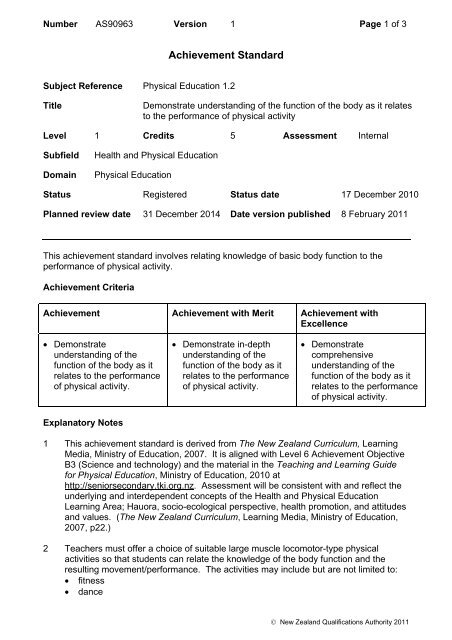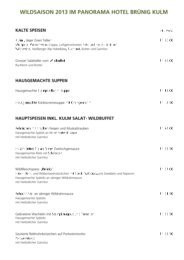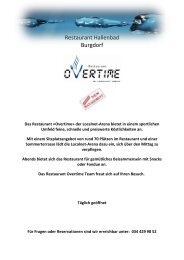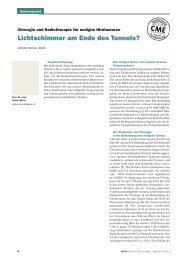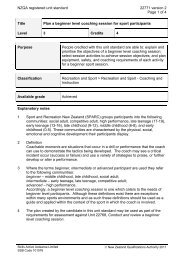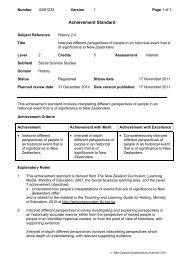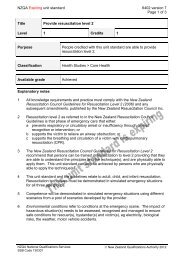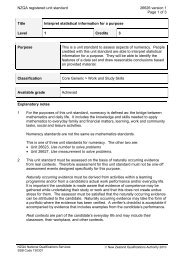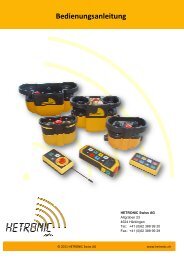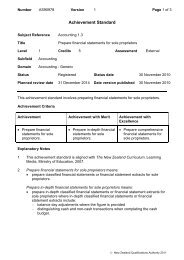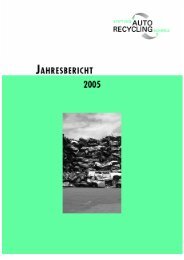90963 Demonstrate understanding of the function of the ... - NZQA
90963 Demonstrate understanding of the function of the ... - NZQA
90963 Demonstrate understanding of the function of the ... - NZQA
You also want an ePaper? Increase the reach of your titles
YUMPU automatically turns print PDFs into web optimized ePapers that Google loves.
Number AS<strong>90963</strong> Version 1 Page 1 <strong>of</strong> 3<br />
Achievement Standard<br />
Subject Reference Physical Education 1.2<br />
Title<br />
<strong>Demonstrate</strong> <strong>understanding</strong> <strong>of</strong> <strong>the</strong> <strong>function</strong> <strong>of</strong> <strong>the</strong> body as it relates<br />
to <strong>the</strong> performance <strong>of</strong> physical activity<br />
Level 1 Credits 5 Assessment Internal<br />
Subfield<br />
Domain<br />
Health and Physical Education<br />
Physical Education<br />
Status Registered Status date 17 December 2010<br />
Planned review date 31 December 2014 Date version published 8 February 2011<br />
This achievement standard involves relating knowledge <strong>of</strong> basic body <strong>function</strong> to <strong>the</strong><br />
performance <strong>of</strong> physical activity.<br />
Achievement Criteria<br />
Achievement Achievement with Merit Achievement with<br />
Excellence<br />
• <strong>Demonstrate</strong><br />
<strong>understanding</strong> <strong>of</strong> <strong>the</strong><br />
<strong>function</strong> <strong>of</strong> <strong>the</strong> body as it<br />
relates to <strong>the</strong> performance<br />
<strong>of</strong> physical activity.<br />
• <strong>Demonstrate</strong> in-depth<br />
<strong>understanding</strong> <strong>of</strong> <strong>the</strong><br />
<strong>function</strong> <strong>of</strong> <strong>the</strong> body as it<br />
relates to <strong>the</strong> performance<br />
<strong>of</strong> physical activity.<br />
• <strong>Demonstrate</strong><br />
comprehensive<br />
<strong>understanding</strong> <strong>of</strong> <strong>the</strong><br />
<strong>function</strong> <strong>of</strong> <strong>the</strong> body as it<br />
relates to <strong>the</strong> performance<br />
<strong>of</strong> physical activity.<br />
Explanatory Notes<br />
1 This achievement standard is derived from The New Zealand Curriculum, Learning<br />
Media, Ministry <strong>of</strong> Education, 2007. It is aligned with Level 6 Achievement Objective<br />
B3 (Science and technology) and <strong>the</strong> material in <strong>the</strong> Teaching and Learning Guide<br />
for Physical Education, Ministry <strong>of</strong> Education, 2010 at<br />
http://seniorsecondary.tki.org.nz. Assessment will be consistent with and reflect <strong>the</strong><br />
underlying and interdependent concepts <strong>of</strong> <strong>the</strong> Health and Physical Education<br />
Learning Area; Hauora, socio-ecological perspective, health promotion, and attitudes<br />
and values. (The New Zealand Curriculum, Learning Media, Ministry <strong>of</strong> Education,<br />
2007, p22.)<br />
2 Teachers must <strong>of</strong>fer a choice <strong>of</strong> suitable large muscle locomotor-type physical<br />
activities so that students can relate <strong>the</strong> knowledge <strong>of</strong> <strong>the</strong> body <strong>function</strong> and <strong>the</strong><br />
resulting movement/performance. The activities may include but are not limited to:<br />
• fitness<br />
• dance<br />
© New Zealand Qualifications Authority 2011
Number AS<strong>90963</strong> Version 1 Page 2 <strong>of</strong> 3<br />
• outdoor education<br />
• adventure-based learning<br />
• games<br />
• team-based sport<br />
• te ao kori<br />
• aquatic activities<br />
• leisure-based activities.<br />
See fur<strong>the</strong>r details in <strong>the</strong> curriculum statement<br />
http://www.tki.org.nz/r/health/curriculum/statement/toc_e.php.<br />
3 Function <strong>of</strong> <strong>the</strong> body involves how <strong>the</strong> human body works in relation to physical<br />
activity. This may include but is not limited to:<br />
• basic <strong>function</strong>al anatomy eg anatomical movement, bones and muscles involved<br />
in <strong>the</strong> movement, agonists, antagonists<br />
• basic principles <strong>of</strong> biomechanics (depending on <strong>the</strong> context used) eg stability,<br />
force summation, levers<br />
• basic physiological responses to large muscle locomotor-type activities<br />
(depending on <strong>the</strong> context used) for example, acute and chronic response to<br />
training, energy systems.<br />
<strong>Demonstrate</strong> <strong>understanding</strong> involves giving an account <strong>of</strong>, and/or giving details <strong>of</strong>,<br />
characteristics. For example, anatomical movement is considered a description <strong>of</strong><br />
<strong>the</strong> way <strong>the</strong> joint moves.<br />
<strong>Demonstrate</strong> in-depth <strong>understanding</strong> involves explaining how and why <strong>the</strong> <strong>function</strong> <strong>of</strong><br />
<strong>the</strong> body is related to <strong>the</strong> performance <strong>of</strong> <strong>the</strong> physical activity.<br />
<strong>Demonstrate</strong> comprehensive <strong>understanding</strong> involves depth and/or breadth <strong>of</strong><br />
knowledge, including:<br />
• <strong>the</strong> relationship between anatomical structure and <strong>the</strong> performance <strong>of</strong> a physical<br />
activity<br />
• <strong>the</strong> use <strong>of</strong> biomechanical principles to explain <strong>the</strong> performance <strong>of</strong> a physical<br />
activity<br />
• <strong>the</strong> relationship <strong>of</strong> physiological responses to <strong>the</strong> intensity <strong>of</strong> a physical activity.<br />
4 Conditions <strong>of</strong> Assessment related to this achievement standard can be found at<br />
www.tki.org.nz/e/community/ncea/conditions-assessment.php.<br />
Replacement Information<br />
This achievement standard replaced unit standard 12540 and AS90068.<br />
© New Zealand Qualifications Authority 2011
Number AS<strong>90963</strong> Version 1 Page 3 <strong>of</strong> 3<br />
Quality Assurance<br />
1 Providers and Industry Training Organisations must be accredited by <strong>NZQA</strong> before<br />
<strong>the</strong>y can register credits from assessment against achievement standards.<br />
2 Accredited providers and Industry Training Organisations assessing against<br />
achievement standards must engage with <strong>the</strong> moderation system that applies to<br />
those achievement standards.<br />
Accreditation and Moderation Action Plan (AMAP) reference 0233<br />
© New Zealand Qualifications Authority 2011


